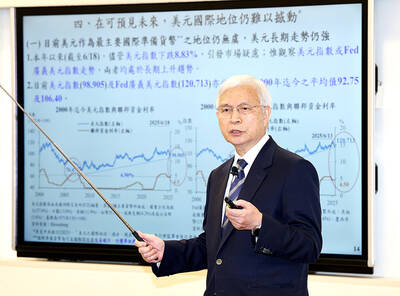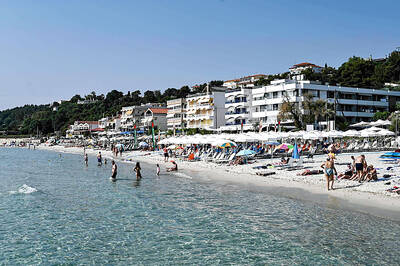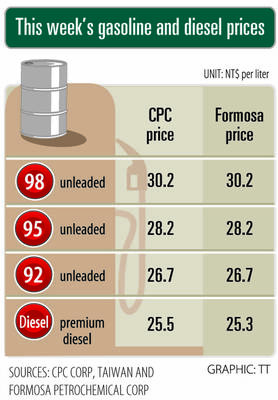Smartphone vendor HTC Corp (宏達電) yesterday said the company is expected to turn profitable this quarter on the strong sales momentum of its latest flagship handset, the HTC One M8, which was launched in March.
The company’s sales last month rose 12.7 percent year-on-year to NT$22.07 billion (US$731.4 million), and HTC projects that sales for this quarter would increase by between 96.37 percent and 111.48 percent sequentially to a range of between NT$65 billion and NT$70 billion, HTC chief financial officer Chang Chia-lin (張嘉臨) said in a conference call.
That is only 0.01 percent lower than the NT$70.7 billion reported in the same period of last year, after the company started selling its flagship M7 handset.

Photo: Bloomberg
Chang said gross margin would reach between 21.3 percent and 22 percent this quarter, compared with 21 percent last quarter and 23.2 percent a year earlier.
The company is expected to post earnings per share of between NT$2.21 and NT$3 this quarter, he said. HTC registered a net loss per share of NT$2.28 for last quarter.
“The M8 is selling better than the M7 from sell-in and sell-out perspectives,” Chang said.
The product is expected to outsell the M7, he added.
HTC has overhauled its internal coordination to avoid issues such as shipment delays or component shortages from happening to the company’s new products this year, he said.
Taoyuan-based HTC also pins hopes on its mid-tier Desire-series models, as it aims to make a turnaround from emerging markets including China and India, Chang said.
The company expects both the M8 and the Desire 816 to be its two top sales drivers through the second half of the year, he said.
“This is a good start for us and we are very excited about the future,” he added.
Despite efforts in cost control, HTC will continue spending on marketing this year to strengthen consumers’ brand awareness and ward off competition from Chinese rivals, Chang said.
Chang did not comment on HTC’s new product lines after being asked if the company plans to sell tablets or wearable devices in the near future.
HTC launched its first and so far only tablet product, the HTC Flyer, in February 2011. The tablet is equipped with a 7-inch display and powered by Google Inc’s Android operating system. However, sales of the product were officially discontinued in December that year.
However, Chang confirmed that some of HTC’s smartphones are being made by contract manufacturers, as reported in the Wall Street Journal on Monday.
“We have been outsourcing production. We think that once our assembly partners attain a manufacturing standard that meets our requirements, we can let them produce [our smartphones],” Chang said.
“The outsourced products have been well-received by consumers,” Chang added, but declined to identify the products or name the assemblers.
He said HTC’s outsourcing volume was not as high as 50 percent of its overall shipments, as reported in the Wall Street Journal, although he could not immediately give an estimate of the actual figure.
According to the Wall Street Journal report, Taiwan’s Compal Electronics Inc (仁寶) and China’s Wingtech Group (聞泰) have been assembling at least three of HTC’s new Desire mid-tier phones, starting in spring this year.

NOT JUSTIFIED: The bank’s governor said there would only be a rate cut if inflation falls below 1.5% and economic conditions deteriorate, which have not been detected The central bank yesterday kept its key interest rates unchanged for a fifth consecutive quarter, aligning with market expectations, while slightly lowering its inflation outlook amid signs of cooling price pressures. The move came after the US Federal Reserve held rates steady overnight, despite pressure from US President Donald Trump to cut borrowing costs. Central bank board members unanimously voted to maintain the discount rate at 2 percent, the secured loan rate at 2.375 percent and the overnight lending rate at 4.25 percent. “We consider the policy decision appropriate, although it suggests tightening leaning after factoring in slackening inflation and stable GDP growth,”

DIVIDED VIEWS: Although the Fed agreed on holding rates steady, some officials see no rate cuts for this year, while 10 policymakers foresee two or more cuts There are a lot of unknowns about the outlook for the economy and interest rates, but US Federal Reserve Chair Jerome Powell signaled at least one thing seems certain: Higher prices are coming. Fed policymakers voted unanimously to hold interest rates steady at a range of 4.25 percent to 4.50 percent for a fourth straight meeting on Wednesday, as they await clarity on whether tariffs would leave a one-time or more lasting mark on inflation. Powell said it is still unclear how much of the bill would fall on the shoulders of consumers, but he expects to learn more about tariffs

Greek tourism student Katerina quit within a month of starting work at a five-star hotel in Halkidiki, one of the country’s top destinations, because she said conditions were so dire. Beyond the bad pay, the 22-year-old said that her working and living conditions were “miserable and unacceptable.” Millions holiday in Greece every year, but its vital tourism industry is finding it harder and harder to recruit Greeks to look after them. “I was asked to work in any department of the hotel where there was a need, from service to cleaning,” said Katerina, a tourism and marketing student, who would

i Gasoline and diesel prices at fuel stations are this week to rise NT$0.1 per liter, as tensions in the Middle East pushed crude oil prices higher last week, CPC Corp, Taiwan (台灣中油) and Formosa Petrochemical Corp (台塑石化) said yesterday. International crude oil prices last week rose for the third consecutive week due to an escalating conflict between Israel and Iran, as the market is concerned that the situation in the Middle East might affect crude oil supply, CPC and Formosa said in separate statements. Front-month Brent crude oil futures — the international oil benchmark — rose 3.75 percent to settle at US$77.01